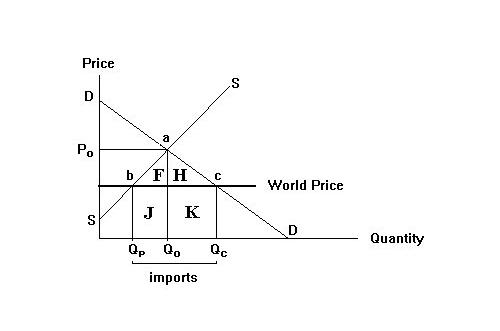
1. the marginal benefit from purchasing another unit of an imported good increases because of the increase in efficiency.
2. the marginal benefit from purchasing another unit of an imported good from foreigners differs from the marginal benefit from purchasing it from domestic producers.
3. the marginal benefit from purchasing another unit of an imported good equals the domestic producers' marginal opportunity cost.
4. none of the above are true.
Choose the option that yields the correct answer.
The correct answer is option 3. Purchasers will keep increasing the quantity bought until the marginal benefit to them equals the marginal cost to them of additional units. That marginal cost will equal the world price. Domestic producers will reduce the quantity produced and sold until their marginal cost equals the price received, which will also equal the world price. The marginal benefit to purchasers will thus equal the opportunity cost to domestic producers. Option 1 is incorrect because the marginal benefit declines as purchasers increase the amount bought in response to the opening up of free trade.
The marginal benefit to purchasers will be always be the same whether they purchase the unit from foreigners or domestic producers as long as the price they pay in the two cases is the same. Here, all exchange takes place at the world price so option 2 is an incorrect choice. Consider the Figure below.

When purchasers expand the quantity bought from Q0 to Qc in response to the introduction of free trade they obtain a gross benefit equal to the area H + K. They pay foreigners the area K in order to obtain Qc so their net gain is the area H. When domestic producers, in response to the introduction of free trade, reduce the quantity produced from Q0 to Qp, resources equal in value to the area F + J are released from producing this good and shifted into the production of something else. Purchasers now buy the amount Q0 - Qp from foreigners at a cost of area J. The savings to the community from this replacement of domestic production with imports equals the area F. The overall efficiency gain is thus H + F.